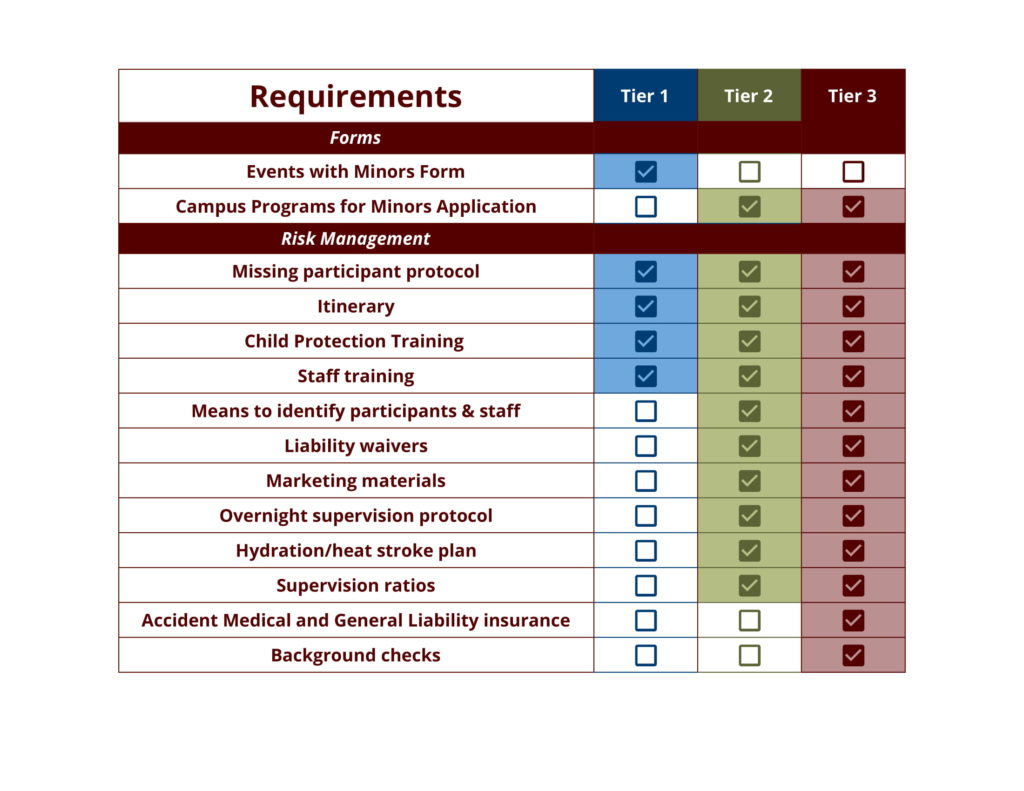University Youth Programs
Our goal is to facilitate efforts that create an environment where youth are consistently safe on our campuses and institutional spaces and where our faculty, staff, and student organizations who engage with youth understand their risk responsibility and implement a high standard of youth protection.
The requirements for hosting campus programs for minors stem from a shared commitment to providing a safe environment and meaningful experience for participants that not only meet the minimum legal requirements but also reflect the University’s core values of Excellence, Integrity, Leadership, Loyalty, Respect, and Selfless Service. The Texas A&M University Rule for Campus Programs for Minors (24.01.06.M1) outlines the requirements for compliance.
What is a Campus Program for Minors?
Commonly referred to as CPMs, Campus Program for Minors are University-sponsored events and activities which typically include all of the following elements:
- The participant group is made up, in whole or in part, of individuals under the age of 18,
- A university department, college, administrative unit, professional school, branch campus, recognized student organization, and/or third party is assuming care, custody, and/or control of the participants, and
- May or may not collect fees from participants.
Requirements for Hosting a Campus Program for Minors
The requirements for hosting a Campus Program for Minors will be determined after a risk assessment has been completed with University Youth Programs. Examples of the levels of requirements based on the risk assessment can be found in the tiers below. For more information on these requirements, visit the Compliance page.
Checklists
For a checklist and timeline of the various requirements for Texas A&M Programs, please click one of the links below:
Requirements by Tier for CPMs
When considering what level your interaction with minors might be, you can use the following guidelines as a start. A full risk assessment should be scheduled with University Youth Programs and together, the appropriate levels of risk management will be decided. The tiers are described in this Overview of Youth on Campus.
All programs are expected to have Check-in/Check-out procedures, have at least two staff members signed up for Code Maroon, a medical response plan, and are required to submit incident reports within 24 hours of an incident.
Review Process
Applications for Campus Programs Minors undergo a review process facilitated by University Youth Programs. While this process is automated, there are several levels of review and approval, so advance planning is key. To help provide a better picture of how the CPM application is processed, here’s a look at the various stages of review:
Program Director
Person responsible for planning, direction, and/or operation of the event
Additional Reviewers*
Optional reviewer spots for individuals with oversight
Sponsoring Department
Department Head of the academic unit or Director of an administrative unit or their assigned designee
Risk & Compliance Review**
A representative from University Youth Programs
60-Day Deadline
Sponsoring Dean***
Dean/Associate Dean of college or similar level for department/division or the assigned designee
14-Day Deadline
*An individual with oversight of the program could be required to be one of the additional reviewers, for example: For recognized student organizations, it will be the primary advisor as listed in StuAct Online or for University Departments it will be the assigned departmental liaison. Programs with lab components will also have additional oversight from the Vice President of Research’s office.
**Please note that CPM applications must be completed, approved by your department’s director/chair, and with UYP in the Risk & Compliance Review stage of the review process no less than 60 days prior to the anticipated start date.
***Please note that all CPM Applications must be submitted annually, reviewed at all levels, and
approved by the respective Sponsoring Dean no less than 14 days before program
activities may occur.


